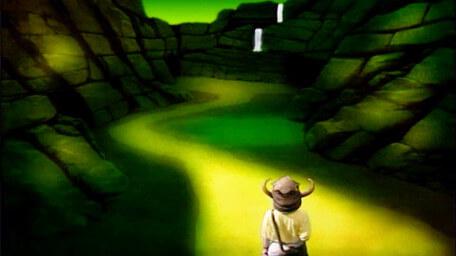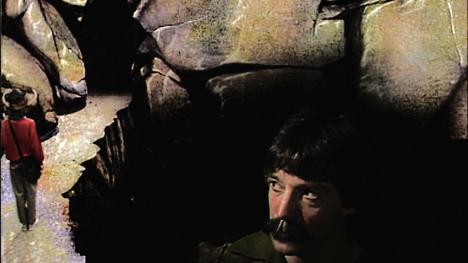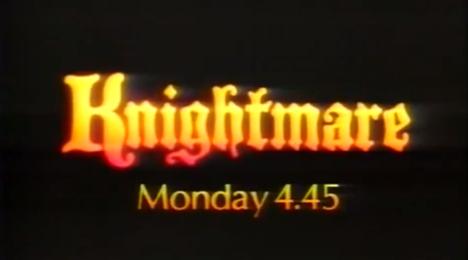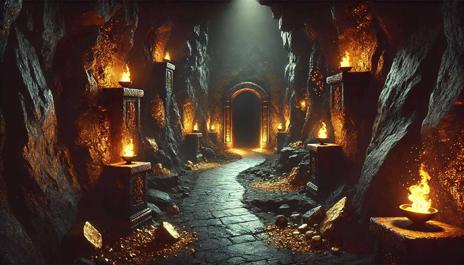David Rowe, the artist behind Knightmare's famous hand painted scenes, discusses the value of human input in a technological world and how a new series might look.
Catching up with David Rowe over an autumn evening feels so quintessentially 'Knightmare'.
But this occasion feels quite loaded too. At knightmare.com, we recently shared a fan experiment that used generative AI to create some dazzling dungeon room designs.
The response was polarised, it's fair to say. Some loved the potential. Some loathed the idea.
It reminds us - if we didn't know already - that technology has leapt several times since the series ended in 1994 and continues to gather pace.
Unthinkably, the once cutting-edge chromakey experiment that brought Knightmare to life is now probably the least compatible element with the tech available at our fingertips.
We were keen to hear David's take on the evolution of design technology and how it has affected the life and work of the artist.

Art 'brought to life'
To face the future, it always helps to understand the past that shaped it. So, we take a journey back to the beginning.
Something that came up repeatedly during the AI design discussion was how the original hand painted artwork took on a life of its own in the show.
As fans, we find ourselves talking about the Vale of Banburn or Death Valley as established venues. It's rather like the suspension of disbelief has never really gone away.

For Rowe in 1987, it was the first use of the Serpent Room - initially Lillith's Domain - that really brought to life the magnitude of the achievement.
"I was just gobsmacked," he says.
"My brief had a strict geometry to it, because it was based entirely on Jean Peyre's grid. That had to be referenced by all the set builders for setting up the studio."
"My contribution had to be pin-accurate to make it work.
"And then you see it in action. Lillith is sat on a ridge that I had painted, exactly mapped to the grid.
"The backstage team had been able to cast shadows across the scene and the dungeoneer separately and retain them.
They'd brought it to life. The illusion became real.

Where is the love?
So, what is it about the human contribution that people cling to, amid the rise of instant gratification and seemingly limitless generative technologies?
Rowe believes it's an appreciation of what's involved, especially when working to the precision the studio grid required from him.
One of his common frames of reference is the recently deceased artist and illustrator, Drew Struzan, whose work includes famous movie posters.
In a tribute, Star Wars creator George Lucas praised Struzan's ability to capture 'excitement, tone and spirit'.
"His creativity, through a single illustrated image, opened up a world full of life in vivid colour," said Lucas.
It's easy to see the parallels with Rowe here. Not just with how Tim Child discovered him through game publishers after coming to admire his work, but also the enduring love of the Knightmare fanbase who found their own fantasy world brought to life at his hand.
"When you're viewing artwork or designs, you're asking yourself - where is the love?" says Rowe. "People that love art recognise the love that's been invested in that art.
"And I did approach Knightmare with a hell of a passion," he adds.
It was 20-hour days. I was living on adrenaline. Being in the zone like that if you're a creative person is just an insane place to be.

Love of the work is key, but perhaps there's some sentimentality involved as well. Art sometimes bears the hallmarks and memories of its time.
For Rowe, the nostalgic pull is equally strong. "The late 80s was a time when technology still felt somewhat new," he recalls.
"People in bedrooms were copying cassettes. You were free to be a bit wild.
"But looking back, even the way you compiled the things you loved - from making mixtapes to carefully setting your VHS - took effort and endeavour.
"None of that escapes any of us old enough to remember," he says.
Digital converts
Given this trip down memory lane, you'd be forgiven for thinking that Rowe prefers to shun modern technology. But that's very much not the case.
"I'll embrace any way, or any medium," he says. "You move with the times and try and add strings to your bow."
Although the hand painted scenes began to be phased out from Knightmare's fourth series in 1990, Rowe still had occasional involvement with the show.
He also contributed to the 2013 Geek Week episode, digitally remastering his original Mount Fear for the spyglass sequences.

Shortly after this in 2015, he began digitally reimagining the Knightmare dungeon as an archaeological hunt, with overgrown and abandoned rooms.
His work, by his own admission, has taken some interesting slants. He's received requests for older, airbrushed techniques applied over modern designs, or vice versa.
But the most telling giveaway about Rowe's view on technology is that he doesn't believe the same kind of artwork he created in the late 1980s would be enough to make a new series of Knightmare successful.
"Still artwork just wouldn’t be appropriate these days," he says.
"I'd be looking for low angles to one side, looking up. Perhaps even camera flythroughs."
We discussed the possibility of gaming engines, such as Unity or Unreal. That's an idea that is picking up traction, including among those who actively work in children's television.
Only, from there, it's easy to drift into other interactive or immersive ideas that might not necessarily make good television.

But Rowe agrees that the makeup of the artistic contributors for a future Knightmare would look quite different. Animators, compositors, possibly computer game programming specialists.
And with that, it's hard to resist the most tempting question - surely, you'd need an artistic director to oversee this new universe of Knightmare?
"Oh yes, absolutely!" says Rowe, not missing a beat.
"You just need to think about how Peter Jackson managed to bring his idea of Middle Earth to life.
"Somebody has to have the vision and bring it together. You need that vision for it to work."
The immortal question that keeps surfacing - could a new series happen? For some, the enthusiasm has never gone away.
Let's hope it never does.



